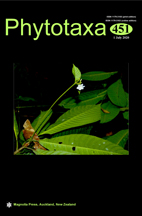Abstract
Three new Amazonian species of the Myrcia splendens group from Brazil are proposed based on morphology and near-infrared spectroscopy of leaves and compared with similar taxa. Myrcia eveae resembles M. splendens and may be recognised mostly by large and oblong leaf blades that tapers abruptly at the apex and large bracts; Myrcia otocalyx also resembles M. splendens, being recognised mainly by pyriform flower buds, campanulate hypanthia that are longitudinally ridged, and sepals of different shapes that are patent on fruit; and Myrcia prismatica is similar to M. deflexa, being recognised essentially by chartaceous leaf blades, pedicels clustered at the tips of inflorescence axes, and oblong fruits with longitudinal edges. Spectral data revealed a unique pattern for each one of the new species and the putative related ones, reinforcing the morphological propositions. This is the first study to use morphology and spectroscopy of leaves combined to propose new species of Myrtaceae. Information on geographical distribution, habitat, conservation status, and an identification key are also provided.

